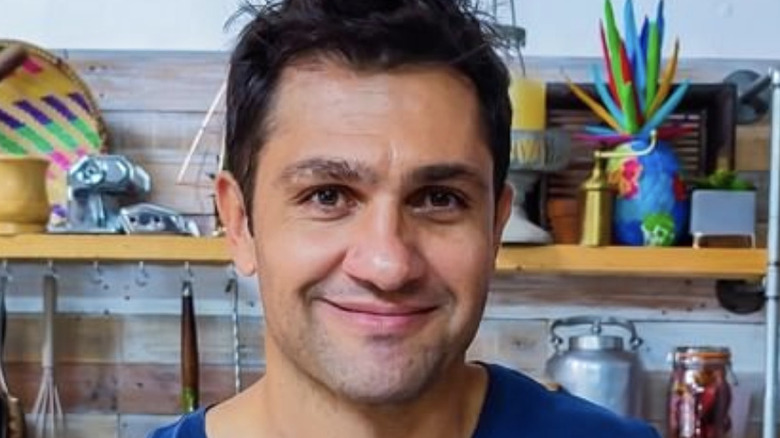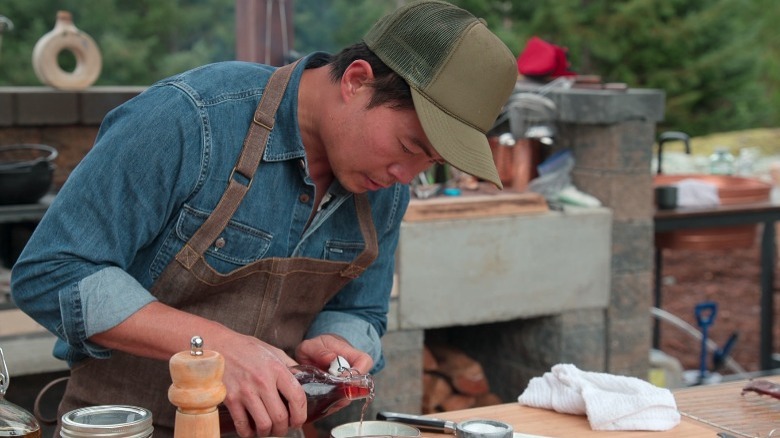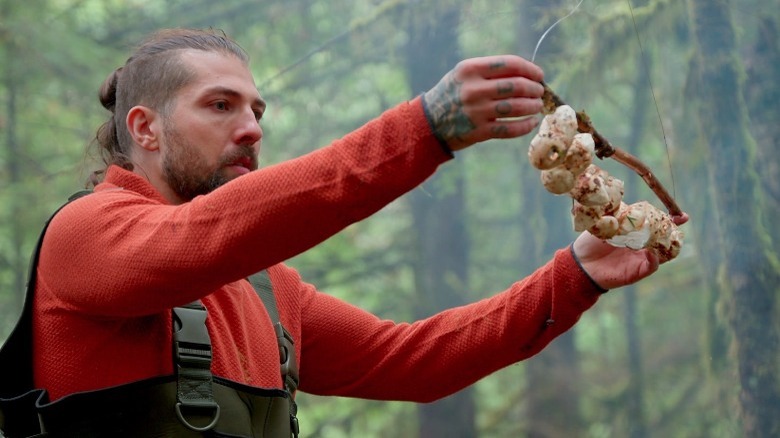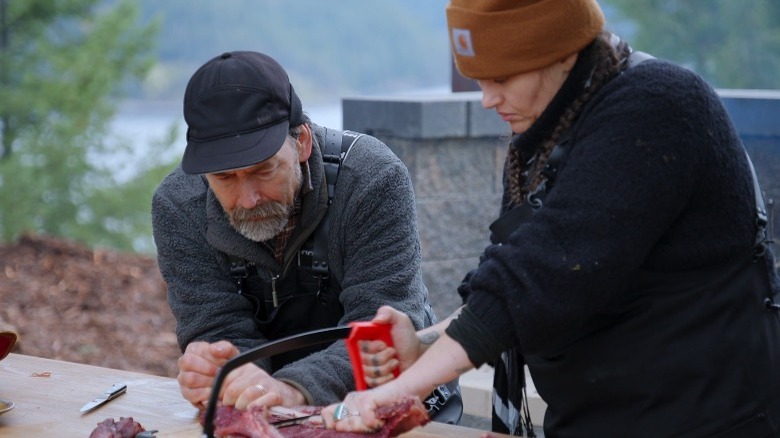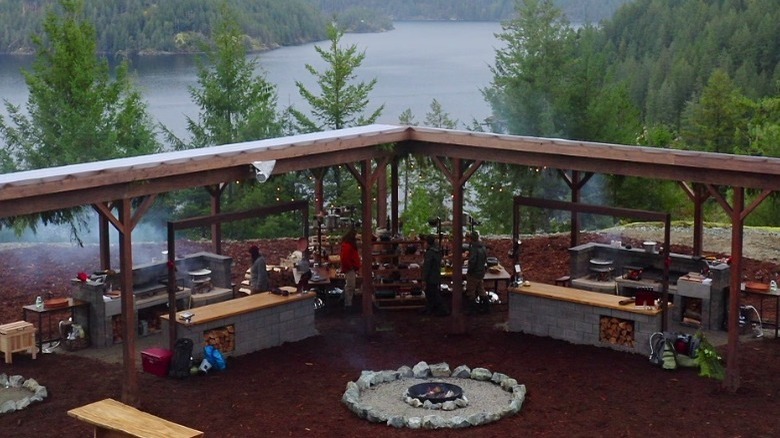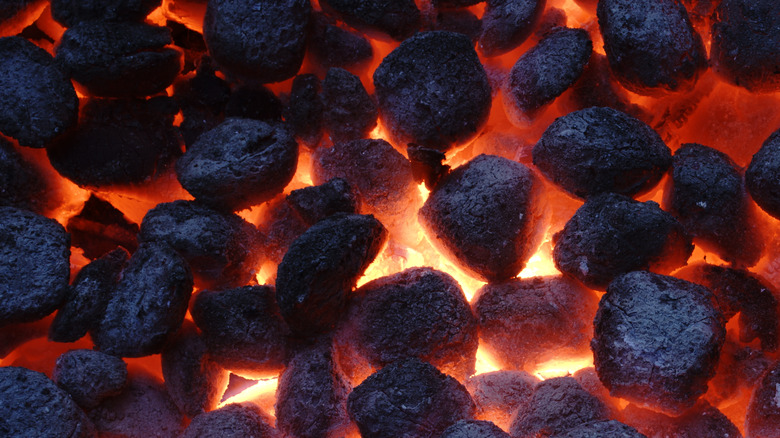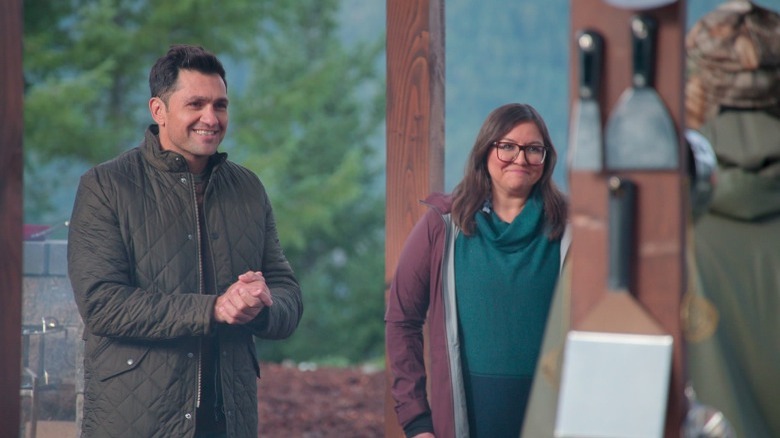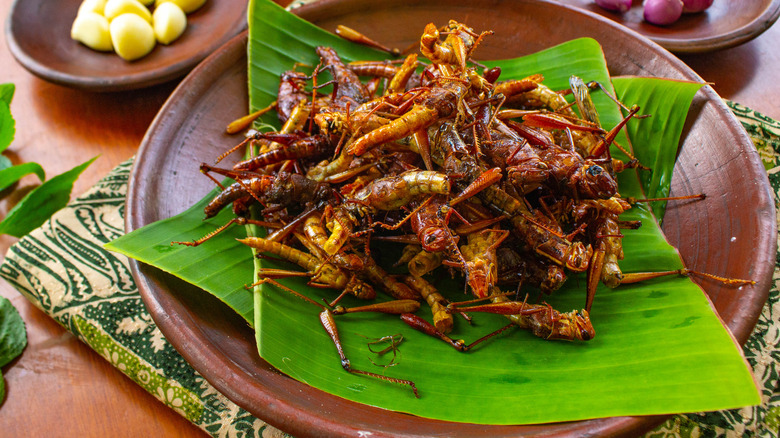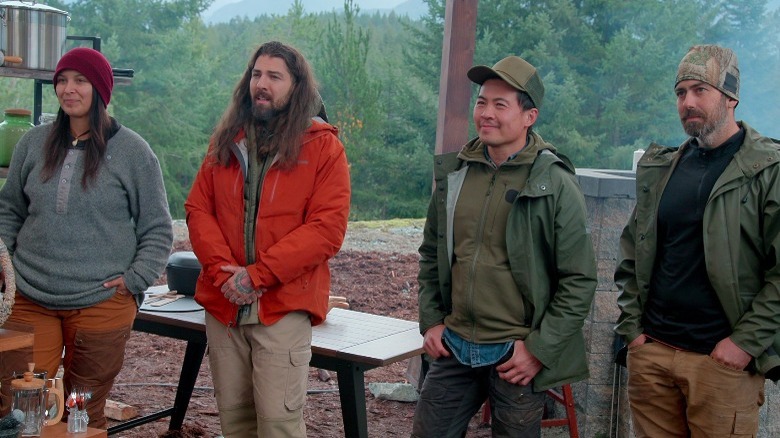Kiran Jethwa On The Wild Challenges Of Chefs Vs. Wild - Exclusive Interview
If you followed Kiran Jethwa on "The Fearless Chef," you know he was destined to host "Chefs vs. Wild." Jethwa, who has traveled from Bolivia to Borneo searching for unusual culinary experiences, told National Geographic that scaling "100-foot palm trees and toddy-tapping on a tightrope in Sri Lanka" live on as his most daredevil memories. But you don't get to see the Bear Grylls side of Jethwa on "Chefs vs. Wild." He was on site but out of sight while the show's contestants endured challenging terrain and "full-on" storms in coastal British Columbia, he told Tasting Table in an exclusive interview.
This is not another cooking competition trying to usurp the throne from "Top Chef" and "Hell's Kitchen." "[As chefs], we click our fingers, pick up the phone, get what we want when we stamp our feet, the ingredients, the equipment, the whole lot of it," Jethwa reflected. "[This show] drives the chefs to reconnect with the importance of understanding where food comes from — that it is precious, and that it should be looked after."
"Chefs vs. Wild" features wildly creative meals concocted from elk loins, sea urchins, oysters, forest berries, and mushroom harvests. You can also watch "Chefs vs. Wild" for the West Coast storms, campsite fires, and strung-out competitors stuck knee-deep in mud. When you're ready to venture into nature yourself, take a page out of Jethwa's book — he gave us some tips and tricks to help you on your own foraging and wilderness cooking journey.
The most dangerous situation on Chefs vs. Wild
We get to see a fair amount of the dangers that the contestants face in the wild. In Episode 1, we see a fire break out at Viet's camp. In Episode 3, Matt shows signs of hypothermia. What was the most dangerous thing you watched somebody go through across the episode?
There's an awful lot that doesn't make it because you've got 40 minutes and so much footage. Probably the time that was the most worrying was ... Sammy and Viet. It was either the first or the second episode we shot. There was a horrendous storm that hit the West Coast, and it took out a lot of the power from Seattle to Vancouver. We were in the middle of that, and it was full-on. We had guys out there, and I was very worried for anyone there. Dead fall, trees falling over, horrendous winds, rain — to be out in the bush in that environment with the limited resources that they have ... that was full-on. That was real.
You were a little bit worried. But the safety teams on the ground did a great job. Everyone had a handle on everything. Stephen Rankin, who's the showrunner, has got bag loads of experience in making this kind of television in these challenging, dangerous environments. He handled it amazingly. Nobody was hurt, but people were tested for sure.
How did you prepare chefs going into this?
That's the point, isn't it? It's not to prepare them too much ... You give them the obvious. You give them information — what they should and shouldn't eat, what they can and can't forage, things that will poison them, things that will harm them, things they shouldn't pick up — the general safety information.
But at the heart of this show — it's maybe something that will come through as an undercurrent — chefs live and work in environments that they're completely accustomed to. We click our fingers, pick up the phone, get what we want when we stamp our feet, the ingredients, the equipment, the whole lot of it. You can perform your magic and impress your guests and your clients.
When you're put into this environment, you don't have any of that. You're not prepared for the reality that food isn't just at the end of a phone, and you have to work for it. It drives the chefs to reconnect with the importance of understanding where food comes from — that it is precious, and that it should be looked after. Aside from the obvious safety stuff that they have to know about, the learning and the journey they go through is part of the show.
What to take with you when you go foraging yourself
This show's going to inspire a lot of people watching to get out into whatever nature surrounds them. What are the main provisions that you'd suggest packing for cooking and foraging if readers prepare to take a short trip into their natural environments?
I genuinely think simpler is better. Rather than cooking with fancy stuff, I would take the basic cooking equipment you need — pot, pan, something to make fire with, some salt and pepper, your basic ingredients. But I would equip them more with knowledge and understanding ... because the more you understand about the environment you're going into, the better your experience will be. The more you know what can and can't be had, the more you'll be able to get.
The most important thing that somebody will take away from an experience like this is not necessarily gourmet food. It is much more respect for food ... Every single kid will remember the time when mom or dad took them fishing and they caught a fish and cooked it over the fire and they ate it themselves. It will be the best fish they ever ate because they invested so much in that experience ... The fact that people have gone out, found it themselves, harvested it themselves, [and] cooked it will be enough to make them understand a different kind of magic in food.
Are there any general foraging items that people overlook?
[One is] a really good knife that could double up as a digging tool. One of the ladies who is part of the production team — she's one of the ethnobotanists. She's a brilliant lady called Fiona, and she has a Ph.D. in ethnobotany ... She had this cool tool that was like a spade and a blade at the same time, so it was a knife and a digging thing. That was a super versatile piece of kit. You could probably harvest or forage most things with that, most mushrooms, most roots.
[Another is] a general purpose fire pot that you can make a stew — something you can dump straight in the coals, cast iron, a couple of feet. It happens to be called a potjie. You can get potjies of different sizes, and they're very versatile outdoor cooking pots because you can make stews in them, you can fry in them. You can saute, you can bake in them. You can do all sorts of stuff ...
Here's another one — newspaper. When you forage, particularly with delicate roots, mushrooms, or things like that, you can pack them in newspaper, which you can keep moist. It's not wet, and it preserves the quality of what you are [foraging] so they don't dry out or get damaged. You wrap them nicely in a newspaper-type thing, and it keeps them safe for when you get back to camp, particularly when you have a backpack and you'll be throwing stuff in a backpack. That's quite useful, newspaper. It sounds crazy, but there it is.
The ingredients that surprised Kiran Jethwa on Chefs vs. Wild
In Episode 3, we see Jade use sea urchin in a dessert. What was the most unexpected use of a foraged ingredient that you encountered?
There is so much. I'm trying to pick one ... You've reminded me of Jade's sea urchin in his dessert, which I was very skeptical about, and it really did work. He pulled that off. He struggled a little bit in his main course, but he brought himself back with that. In Episode 5, Chef Katie Coss took spruce tips and roasted them in a dry pan. The result was like a spruce tip popcorn crouton that she put on a foraged forest salad — delicious and very effective. In Episode 7, Chef Luca Ballard made a crab custard for his dessert. His execution was not very good — he couldn't control the heat for the baked custard — but the flavor worked, and it was a bold use of an ingredient.
Mushrooms are the star of a lot of the foraged ingredients that we see in the show. Can you give mushroom enthusiasts your top tips for foraging mushrooms?
They're one of the most exciting things to go foraging for. They're so rewarding in many respects. When you find them, they look so beautiful on the forest floor, almost like they don't belong there. They kind of pop ... The mushrooms that stood out for me in this particular show were matsutake mushrooms that Sammy found, pine mushrooms. They are a gold standard mushroom, but he was the only person who found them on the show.
We had a beautiful cauliflower mushroom, which is rare. That's a spectacular-looking mushroom and a spectacular-tasting mushroom. It tastes like egg noodles in a weird way. They have the same texture. Golden chanterelles — they are different from a regular chanterelle — there were a few of those. Again, [they are a] beautiful, bright, yellow-orange color and delicious. There were a lot of oyster mushrooms. They were a bit more common. The regular chanterelles are a bit more common.
The top three would be the pine mushrooms, cauliflower mushrooms, and golden chanterelles. If you're in that environment at the right time of year, you will find those mushrooms. But we were at the cusp of winter, and the mushrooms are starting to struggle a little bit ... From people who I spoke to who live in the area, at the right time of year in that environment, it's rewarding. You can get tons and tons and tons of mushrooms. They're so delicious, so satisfying, and so healthy.
The key to cooking with fire
On the show, chefs have to know how to cook with fire and coals quite a bit. That's the premise of an outdoor kitchen. Did you pick up any creative ways to do so that you hadn't seen before?
Without sounding arrogant, probably not, but I've cooked with fire my entire life ... I've done a lot, so I know most of the tricks in the book. A key point of the show is that the chefs have no electricity and the kitchen has no power at all, so everything was fire and using your hands, which also made it challenging. We get very used to having the blenders and mixers and big machines and all kinds of stuff.
Could you give readers beginning their outdoor cooking journeys any tips?
A lot of it is practice and understanding how to control the heat. Now, if you want to bake with fire, what you require is coals. You need to burn your wood all the way down until it's pretty much these ashy coals, and that's when you can start baking with fire. If you want to grill, you need the wood burning somewhere in between ... Most people know how to grill, let's be honest. It's the most common form of cooking.
But control and finding out what stage to use the wood as it's burning and to get it ... because it has a lifespan, and to control that, a lot of that is practice. How do you explain that in words without actually showing somebody? It's quite difficult. The simple way of answering that question is a lot of it is practice, and it is learning about how to control the flow of the air — when to bring it in, when to stop it — because it's all about air, and that's what controls the fire.
How to successfully bake a cake with only coals
We see somebody making a cake with a cast iron pot and coals on the top. Could you walk us through that particular method of baking with coals?
It's quite commonly done. First of all, you need a vessel that will be a barrier between food and coals, so it must have a lid and not let any ashes in. A cast iron pot is often a very good option. You got to remember, the idea of putting the coals — if you had some coals, you dump the pot straight in. If you're baking a cake, you want to push the coals up around the side and then put them on top, because what you're doing is mimicking what an oven does. An oven bakes from all around, not just the direction from underneath. You're radiating heat from all the way around it. As much as possible, that's what you're trying to mimic.
The challenge with that sort of baking is that the heat is directly against the cast iron pot, so you could very easily burn the outside and not cook the inside. That's why you need to get the heat right down to the point where it's ashy ... If you think about if you're baking at home — and I work in degrees Centigrade, so you're going to have to convert this for cooking outside.
Generally, you bake a cake at about 180 degrees Celsius, so 180 is 350-ish Fahrenheit. At that temperature, you could put your hand in the oven for about 5 to 10 seconds before it got uncomfortable. When you want to know that your fire's ready, you do the same thing. Put your hand there. It needs to be uncomfortable after about five seconds but not so hot that it would easily burn. You know you're at a place where, "Okay, I'm about ready to go with this." Dump your pot in, pack all the coals all the way up the side. Stick some on top, and leave it for 45 minutes and hope.
The times on Chefs vs. Wild that Kiran Jethwa wanted to intervene the most
As you're following the contestants on their foraging journeys, were there any times that alarm bells started ringing in your head, like, "This isn't going well," or "I wouldn't have done that"?
Yeah — a combination of all of those. There were times when there were people really struggling. They weren't finding enough. Then they managed to get themself together. All of them would eventually come out of the woods with enough to make great dishes, but there was definitely moments in a lot of their actual journeys where you're like, "Hmm."
What's the top time when you held yourself back from intervening?
I can't remember which episode it was, but one of the contestants had the idea to bring back termites. They are, if treated well, a fantastic ingredient because they're quite nutty and buttery in flavor. They were going to deep fry them. That was the plan. I understood why; [they wanted to] get this crispy sort of ... But I was like, "Man, if you worked that hard to find these tiny little things and then you drop them in hot oil, you are going to wreck them. If you actually treated them slightly differently, you could extract so much more flavor out of that ingredient than incinerating it in hot oil."
That was one of the times I wanted to be like, "Don't do that." Another time [was] when Chef Katie [Coss] took her wonderful sea spaghetti seaweed and cooked it! It totally destroyed the ingredient. Also, when Chef Mason Snyder's survival partner was filleting the trout he caught and was making a complete mess of it, [they] again nearly destroyed a prize ingredient.
Kiran Jethwa predicts eating insects will inevitably become mainstream
We get to see contestants cook quite a bit with insects in this series. Cooking with insects seems to be continually hyped and then forgotten about in mainstream Western media. Do you think we'll ever get to the point where cooking with insects becomes a common practice in places like the United States?
I'm absolutely convinced of it. It's inevitable. In the next 20, 25 years, it will be part of the mainstream diet. There are many reasons for that.
I have a lot of experience with insects. I am a big proponent of them ... They are becoming, as we speak, more and more mainstream. The bottom line is it's far more environmentally friendly to create the same amount of protein out of insects than animals. You need less resources across the board, less land resources, less food resources, less water resources. The conversion rate of feed to protein is much higher. The actual quality of the protein is far higher. The environmental cost is far lower, and if you can get your head around them, they are really tasty.
They're already part of a lot of diets, the mainstream of many, many other cultures' diets. In the Western diet — so to speak — they will start to become more mainstream. The way it will be fed in [is] they'll be ingredients in things, like a protein bar will be fortified with insect protein so you won't necessarily know you're eating it. Then, as we get our heads around it in a couple of generations, I believe you'll find little packets of snacks, like crickets in barbecue flavor, and you'll be able to eat them as snacks. They'll be in every gym, in every health store ... I've got crickets in packets in my house. They're such high-quality protein and fiber [that] it makes sense to eat them from a nutrition point of view. I'm 100% convinced of that.
From a culinary point of view, they give you some interesting options. I can remember way back, many years ago, I was in Uganda, East Africa. I came across these guys who were doing grasshoppers in tomato sauce, and they deep fried them. I ate them. It was one of the culinary finds of my life because they were delicious. Not, "Oh, this is good for the planet and I could just about stomach it" — I couldn't stop thinking about it. It was so good, I started selling it in the restaurant because I wanted people to be exposed to that.
Once you get people past the idea of eating an insect, they were like, "Wow." It wasn't about forcing yourself to eat them. They're properly delicious food. In the next 20 to 30 years or 20-odd years, they will become part of our mainstream diet.
How to get cast on Chefs vs. Wild
What would it take for someone to be cast in Season 2 of the show?
You obviously need to be a good chef. That helps. You do need to be a good chef because the standards required of the chefs from a culinary point of view are high. You need to have a passion for the outdoors. I don't think you have to have experience of the outdoors. You have to have a passion for it and be robust enough to put yourself through a challenging time. It would help to have some outdoor experience.
If you want to get cast, go and practice a bit. Have a bit of fun in the outdoors; do some foraging. You'll learn very quickly how rewarding it is, whether or not you got cast in the show — just by doing that, you've won a little bit. That would be it ... Primarily, there should be a passion for the principles behind the show, which are to find amazing food in the wild, cherish it and love it, value it, and make incredible dishes out of it.
Catch Kiran Jethwa on "Chefs vs. Wild," which is streaming now on Hulu.
This interview was edited for clarity.
